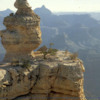
Navaho religion explains the universe as ordered, beautiful and harmonious. It emphasizes rituals to restore harmony and balance. Each ritual is inspired by myths illustrating the origins of the people through different worlds or existences, the mountains, the sun and the moon.
The Navaho today have four reservations; the largest one surrounds the Hopi Pueblo reservation in Arizona. The other three are in New Mexico. About 190,000 Navaho live in the U.S., with 146,000 on reservations on the high Colorado plateau. Most precipitation falls in the winter and summer. Unpredictable and intense summer thunderstorms often wash out dirt roads and trigger flash floods, damaging ground cover and crops. The rest of the year, temperatures are high and humidity low.
Originally hunters and gatherers, the Navaho developed an agricultural economy through contact with their Pueblo neihbors and the Spanish. While they depend on agriculture and livestock, they supplement their income through commerce in native crafts. In addition, contracts for resources such as timber, oil, coal, uranium and gas provide the Navaho nation with income, and many men work on the railroads.
Until the 1850s, the Navaho were independent of colonial, political and missionary controls. They maintained an informal, decentralized political, social and economic system centered on local land-use groups organized around clan, domestic and geneaological affiliations. Since the 1930s, conflicts over U.S.-directed change--involving acculturation, relocation, livestock reductions and land disputes--have raged between the Navaho and Washington.


